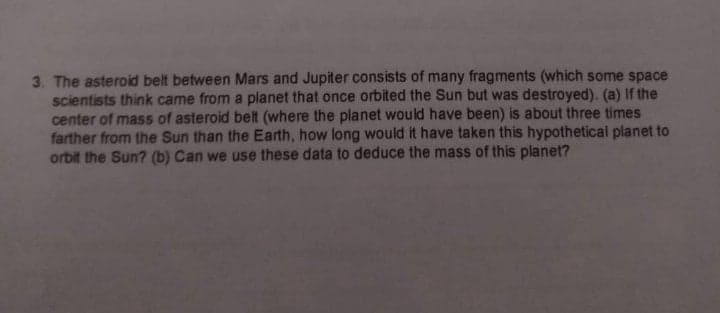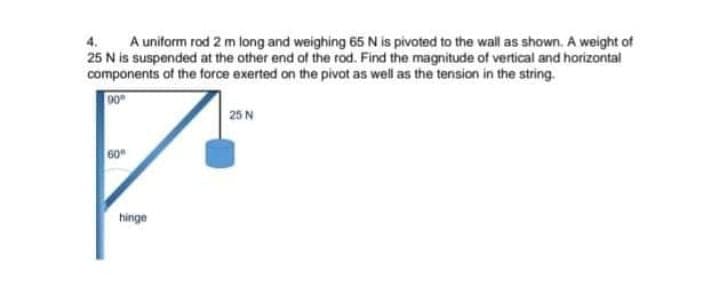3. The asteroid belt between Mars and Jupiter consists of many fragments (which some space scientists think came from a planet that once orbited the Sun but was destroyed). (a) If the center of mass of asteroid belt (where the planet would have been) is about three times farther from the Sun than the Earth, how long would it have taken this hypothetical planet to orbit the Sun? (b) Can we use these data to deduce the mass of this planet?
3. The asteroid belt between Mars and Jupiter consists of many fragments (which some space scientists think came from a planet that once orbited the Sun but was destroyed). (a) If the center of mass of asteroid belt (where the planet would have been) is about three times farther from the Sun than the Earth, how long would it have taken this hypothetical planet to orbit the Sun? (b) Can we use these data to deduce the mass of this planet?
Principles of Physics: A Calculus-Based Text
5th Edition
ISBN:9781133104261
Author:Raymond A. Serway, John W. Jewett
Publisher:Raymond A. Serway, John W. Jewett
Chapter10: Rotational Motion
Section: Chapter Questions
Problem 32P
Related questions
Topic Video
Question

Transcribed Image Text:3. The asteroid belt between Mars and Jupiter consists of many fragments (which some space
scientists think came from a planet that once orbited the Sun but was destroyed). (a) If the
center of mass of asteroid belt (where the planet would have been) is about three times
farther from the Sun than the Earth, how long would it have taken this hypothetical planet to
orbit the Sun? (b) Can we use these data to deduce the mass of this planet?

Transcribed Image Text:A uniform rod 2 m long and weighing 65 N is pivoted to the wall as shown. A weight of
25 N is suspended at the other end of the rod. Find the magnitude of vertical and horizontal
components of the force exerted on the pivot as well as the tension in the string.
25 N
60
hinge
Expert Solution
This question has been solved!
Explore an expertly crafted, step-by-step solution for a thorough understanding of key concepts.
This is a popular solution!
Trending now
This is a popular solution!
Step by step
Solved in 3 steps with 2 images

Knowledge Booster
Learn more about
Need a deep-dive on the concept behind this application? Look no further. Learn more about this topic, physics and related others by exploring similar questions and additional content below.Recommended textbooks for you

Principles of Physics: A Calculus-Based Text
Physics
ISBN:
9781133104261
Author:
Raymond A. Serway, John W. Jewett
Publisher:
Cengage Learning

College Physics
Physics
ISBN:
9781285737027
Author:
Raymond A. Serway, Chris Vuille
Publisher:
Cengage Learning

Physics for Scientists and Engineers: Foundations…
Physics
ISBN:
9781133939146
Author:
Katz, Debora M.
Publisher:
Cengage Learning

Principles of Physics: A Calculus-Based Text
Physics
ISBN:
9781133104261
Author:
Raymond A. Serway, John W. Jewett
Publisher:
Cengage Learning

College Physics
Physics
ISBN:
9781285737027
Author:
Raymond A. Serway, Chris Vuille
Publisher:
Cengage Learning

Physics for Scientists and Engineers: Foundations…
Physics
ISBN:
9781133939146
Author:
Katz, Debora M.
Publisher:
Cengage Learning

University Physics Volume 1
Physics
ISBN:
9781938168277
Author:
William Moebs, Samuel J. Ling, Jeff Sanny
Publisher:
OpenStax - Rice University

Physics for Scientists and Engineers, Technology …
Physics
ISBN:
9781305116399
Author:
Raymond A. Serway, John W. Jewett
Publisher:
Cengage Learning

College Physics
Physics
ISBN:
9781938168000
Author:
Paul Peter Urone, Roger Hinrichs
Publisher:
OpenStax College